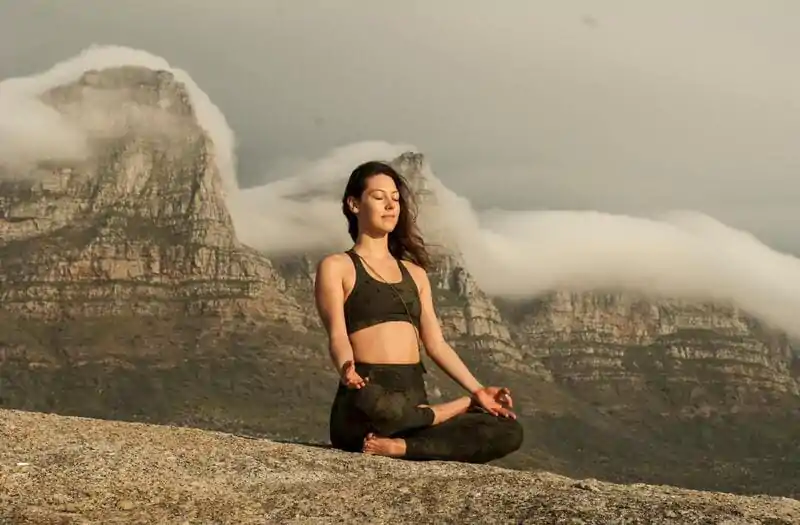Are you looking for a way to find inner peace and balance amid life’s chaos? Meditation can be the answer, but to truly benefit from it, you need to understand the concept of grounding.
Grounding in meditation is a way that helps to bring you to the present and reorient you to the here and now. Grounding helps you stay present and reduce stress. Being grounded also means you have a strong connection with who you are, which brings you physical and emotional balance, as well as feel more connected to the world around you.
In this blog, we will explore what grounding means in meditation, why it is essential, and how it can help you experience greater clarity and calmness in your daily life. Whether you are new to meditation or an experienced practitioner, understanding grounding can help you deepen your meditation practice and achieve a more fulfilling life.
Grounding in Meditation
Grounding in meditation practice involves ways that help individuals establish a sense of connection with the present moment, their physical body, and the immediate environment. It often includes exercises such as deep breathing, visualization, or mindfulness techniques that encourage a heightened awareness of sensations in the body or surroundings.

By grounding oneself during meditation, individuals can cultivate a greater sense of calm, reduce stress, and foster a deeper connection with themselves and the world around them. This practice is often utilized in various meditation traditions to promote relaxation, mindfulness, and a more centered state of being.
Grounding Techniques in Meditation
In meditation, grounding is all about feeling more connected, stable, and peaceful. Here are some simple techniques to help you with grounding:
- Mindful Breathing: To practice grounding, start by taking slow, deep breaths. Close your eyes, sit comfortably, and focus on your breath. Feel the air coming in and out. This helps you stay in the present moment.
- Bodyscan: In this technique, you pay attention to each part of your body, from your head to your toes. As you do this, imagine each part of your body is getting heavy, and feel yourself sinking deeper and deeper into your body. This makes you more aware of your body and more grounded in the present.
- Visualization: Imagine that you’re like a strong tree with roots going deep into the earth. As you breathe, visualize these roots getting stronger, connecting you with the earth. This technique is excellent for feeling grounded in meditation.
- Nature Connection: Practice your grounding meditation outside in nature. Sit on the grass or feel the sand under your feet. This direct contact with the Earth can enhance your sense of grounding.
These techniques for grounding can help you find calm, reduce stress, and stay more focused. Give them a try, and you’ll discover a more profound sense of peace and stability in your meditation practice.
Here's a step-by-step guide on how to practice grounding for beginners:

- Find a Quiet Space: Find a quiet and comfortable space where you won’t be disturbed. This can be indoors or outdoors, depending on your preference.
- Sit Comfortably or Lie Down: Sit in a chair with your feet flat on the ground or a cushion with your legs crossed. Alternatively, you can lie down on your back with your arms by your sides. Choose a position that feels comfortable for you.
- Close Your Eyes: Gently close your eyes to minimize distractions and help you focus inward.
- Take Deep Breaths: Start by taking a few deep breaths. Inhale slowly through your nose and exhale through your mouth. Feel the breath entering and leaving your body. This is the initial step to center yourself and begin grounding.
- Focus on Your Breath: Now, shift your attention to your breath. Pay close attention to the rise and fall of your chest and the expansion and contraction of your abdomen as you breathe. Your breath is your anchor to the present moment.
- Visualize Roots: Begin to visualize roots extending from your body into the earth. These roots are like those of a strong, grounded tree. Imagine them going deeper and connecting you firmly to the earth. This mental imagery is a key part of grounding in meditation.
- Release Distractions: As you continue to breathe and visualize your roots, let go of any distracting thoughts. Picture them leaving your body and being absorbed by the earth. This helps you stay focused and grounded.
- Body Awareness: Slowly scan your body from head to toe. Notice any sensations, tensions, or discomfort. As you do this, imagine each part of your body becoming heavier and sinking into the Earth. This deepens your connection with your physical self and the Earth.
- Stay Present: Throughout your meditation, stay present with your breath and the feeling of being connected to yourself. If your mind starts to wander, gently bring your focus back to your breath and your grounding roots.
- Take Your Time: There’s no rush. Practice grounding for as long as you feel comfortable. You can start with just a few minutes and gradually extend your sessions as you become more experienced.
- End with Gratitude: When you’re ready to finish your grounding, take a moment to express gratitude for the calm and stability you’ve found. Slowly open your eyes and return to your day with a sense of grounding that you can carry with you.
Challenges with Grounding in Meditation
In meditation, grounding can be a helpful practice, but it’s not always easy. Here are some common challenges you might encounter and practical ways to overcome them, along with examples:
Restless Mind
- Challenge: Your mind may wander, making it hard to stay focused on grounding.
- Solution: Acknowledge the distractions and gently bring your focus back to grounding yourself. For example, if you’re visualizing roots, re-imagine them connecting you to the Earth when your mind drifts.
Impatience
- Challenge: You might feel impatient and want immediate results.
- Solution: Remember that grounding in meditation takes time. Be patient with yourself and trust the process. Think of it like growing real roots—they don’t happen overnight.
Physical Discomfort
- Challenge: Physical discomfort like pain or restlessness can make it difficult to stay grounded.
- Solution: Adjust your position or use props like cushions or chairs for comfort. For example, if you’re sitting cross-legged and your legs become uncomfortable, change to a more comfortable sitting position or use a cushion for support.
Overthinking
- Challenge: Overthinking the meditation process or analyzing it too much can hinder grounding.
- Solution: Keep it simple. Focus on the basics of your chosen grounding technique, whether it’s your breath, visualization, or physical sensations. For instance, if you’re using the breath, just concentrate on the sensation of each inhale and exhale.
Distractions
- Challenge: External noises or interruptions may break your concentration.
- Solution: Accept that distractions happen. When you hear a noise or experience an interruption, acknowledge it and then bring your attention back to your grounding practice. For example, if a car passes by, acknowledge the sound, and then re-focus on your breath or visualization.

Lack of Consistency
- Challenge: It can be challenging to establish a consistent grounding meditation routine.
- Solution: Set a regular schedule for your meditation practice. Start with a few minutes a day and gradually increase the time. For example, commit to five minutes of grounding each morning when you wake up.
Doubt
- Challenge: You might doubt whether grounding is working for you.
- Solution: Trust the process. Reflect on how you felt before and after the practice. Often, the benefits of grounding become more apparent over time. Keep a journal to track your progress, which can help you see improvements.
Unrealistic Expectations
- Challenge: Expecting too much from a single meditation session can lead to disappointment.
- Solution: Remember that each session is unique. Instead of expecting a perfect experience, focus on being present and cultivating a sense of grounding, even if it’s subtle. For example, if you were expecting to feel completely stress-free, remind yourself that every bit of stress reduction is a step in the right direction.
Impersonal Connection to Grounding
- Challenge: Sometimes, you might not feel a personal connection to the grounding meditation technique.
- Solution: Customize your grounding practice to what resonates with you. If visualizing roots doesn’t feel personal, use a symbol or imagery that speaks to you. For instance, imagine a serene beach if that feels more meaningful.
Overdoing It
- Challenge: Practicing grounding too intensely or for too long can lead to frustration or burnout.
- Solution: Balance is key. Start with shorter sessions and gradually extend the time as you become more comfortable. For example, if you’re new to grounding, begin with five minutes and increase it by one minute each week.
Remember that challenges in grounding meditation are natural, and they don’t mean you’re doing it wrong. They are opportunities for growth and learning. With persistence and patience, you can develop a more effective and satisfying grounding practice.
Conclusion

Grounding in meditation is a powerful practice that offers a wide range of benefits for both mental and physical wellbeing. In a world filled with distractions and stress, the ability to establish a deep connection with oneself and the Earth is a valuable skill.
By incorporating grounding techniques into your daily meditation practice, you can find serenity, reduce anxiety, enhance your focus, and become more resilient in the face of life’s challenges. So, take a moment to ground yourself and experience the profound sense of peace and stability it can bring to your life.
Curious to know more about meditation? Discover the amazing benefits of meditation! Join our free live guided Inner Peace Sessions—an opportunity you don’t want to miss!







